Investigating the Mechanism of Continuous–Discrete Coupled Destabilization of Roadway-Surrounding Rocks in Weakly Cemented Strata under Varying Levels of Moisture Content
Abstract
:1. Introduction
2. Continuous–Discrete Coupling Modeling
2.1. Principle of Continuous–Discrete Coupling Calculation

2.2. Modeling
2.3. Calibration and Selection of Mesoscopic Parameters
2.4. Pilot Program
3. Damage Law of Roadway-Surrounding Rock in Weakly Cemented Strata under Different Water Conditions
3.1. Continuous–Discrete Coupled Data Consistency Analysis
3.2. Response Analysis of Moisture Content on the Deformation of Roadway-Surrounding Rock
3.2.1. Mechanism of Action of the Anchor Solid
3.2.2. Deformation Pattern of the Perimeter Rock of the Roadway
3.2.3. Distribution Pattern of Cracks in the Roadway-Surrounding Rock
3.2.4. Evolutionary Patterns of the Roadway-Surrounding Rock and Anchored Body Force Chains
4. Mechanism of Rupture of Roadway Perimeter Rock in Water-Rich and Weakly Cemented Strata
4.1. Anchor Solid Slippage
- Elastic phase (OA): The displacement between the anchorage interface is minimal, with no slippage between the anchorage and the surrounding rock. The interaction between the two results in elastic deformation, as represented by the following functional relationship:
- Shear-hardening stage (AB): The shear displacement incrementally increases while the curve’s slope decreases. The shear stress at the anchorage interface reaches the peak stage. Given the rough contact interface and low strength of the weakly cemented rock, the anchorage shear stress exhibits a shear-hardening phenomenon upon reaching a specific value due to compression at the anchorage interface:
- Decohesion stage (CD): Weakly cemented rocks are poorly cemented. When the shear stress at the anchorage interface surpasses the peak shear stress, the anchoring agent and the surrounding rock are detached. During this stage, the friction at the anchorage interface serves as the primary load-bearing capacity and some residual strength is maintained:
4.2. Anchor Solid Shear Damage
5. Conclusions
- When the moisture content of the surrounding rock ω < 5.5%, the evolution of the cracks and force chains is relatively stable. Fewer cracks are present around the roadway, and weak force chain areas are confined to the roadway face. The anchoring system can then exert a certain level of control on the roadway. When the moisture content ω > 5.5%, the number of cracks suddenly increases. The force chain around the roadway transitions from a strong to a weak chain or even disappears, resulting in the severe deformation of the roadway. The roadway roof is most significantly affected by the moisture content. In particular, a water content ω = 5.5% is the water content threshold for the destabilization and damage of the tunnel perimeter rock.
- The failure mode of the anchoring system within the roadway can be classified into two types. The first type involves the loosening and collapse of the roof when the anchoring force is insufficient or fails. This failure mode becomes evident when the bonding effect between the anchor agent and the surrounding rock weakens due to water exposure, resulting in relative slippage and gradual detachment from the surrounding rock. The second type is the shear damage of the anchoring system. In the weakly cemented rock layer within the anchorage range, the roof anchoring system typically incurs shear damage, leading to the failure of the roof-support structure.
- In water-rich and weakly cemented strata, anchor failure in the roadway-surrounding rock occurs gradually due to adhesive slippage at the anchor interface. This process can be divided into five stages: elastic, elastic–shear hardening, elastic–shear hardening–decohesion, shear hardening–decohesion, and complete decohesion.
- The study of the failure law, morphology, and mechanism of the roadway-surrounding rock under different moisture content conditions provides a basis for studying the control of roadway-surrounding rocks in weakly cemented strata. In addition, this study holds a significant value for numerical simulations of underground mining, enabling a more accurate inversion and reproduction of strong rock pressure disaster phenomena observed in the mining areas of weakly cemented strata in Western China.
Author Contributions
Funding
Data Availability Statement
Conflicts of Interest
References
- Wen, S.Y.; Han, L.J.; Zong, Y.J.; Meng, Q.B.; Zhang, J. Study on acoustic emission characteristics of sandstone uniaxial compression test with different moisture content. Coal Sci. Technol. 2013, 41, 46–48+52. [Google Scholar]
- Teng, T. Experimental Study on Acoustic Emission Characteristics of Red Sandstone under Uniaxial Compression with Different Moisture Content. Master’s Thesis, Jiangxi University of Science and Technology, Ganzhou, China, 2019. [Google Scholar]
- Meng, Q.; Qian, W.; Han, L.J.; Yu, L.Y.; Wang, C.K.; Zhou, X. Experimental study on formation mechanism and mechanical properties of regenerated structure of very weak cemented rock mass. Rock Soil Mech. 2020, 41, 799–812. [Google Scholar]
- Zhang, S. Study on the Weakening Mechanism of Interfacial Stability of Mudstone and Anchor with Different Moisture Content. Master’s Thesis, China University of Mining and Technology, Xuzhou, China, 2020. [Google Scholar]
- Xu, H.W. Study on Damage Mechanism of Water-Rich Soft Rock and Supporting Control of Roadway. Master’s Thesis, Shandong University of Science and Technology, Qingdao, China, 2017. [Google Scholar]
- Zhao, Z.; Yang, P.; Zhang, M.Z.; Lv, X.Z.; Chen, S.J. Stability of weakly cemented soft surrounding rock under combined effect of water environment and inhomogeneous ground stress. J. Min. Saf. Eng. 2022, 39, 126–135. [Google Scholar]
- Lu, H.; Qin, B.; Wang, B. Study on surrounding rock failure and control technology of roof water drenching roadway. Coal Technol. 2021, 40, 25–29. [Google Scholar] [CrossRef]
- Wang, X.; Zhang, H.; Li, G. Study on surrounding rock control technology of weakly cemented water-rich roof in roadway. Coal Sci. Technol. 2018, 46, 88–92+98. [Google Scholar]
- Fang, X.; Xue, G.; Liang, M.; Fan, H. Micro-failure mechanism and bolt-grouting reinforcement support technology of water-bearing sandstone roadway. J. China Univ. Min. Technol. 2014, 43, 561–568. [Google Scholar]
- Zhang, C.; Bai, Q.; Han, P. A review of water rock interaction in underground coal mining: Problems and analysis. Bull. Eng. Geol. Environ. 2023, 82, 157. [Google Scholar] [CrossRef]
- Sun, L.; Jiang, Z.; Long, Y.; Ji, Q.; Wang, Z.; Fan, Y.; Hao, Y. Influence of mesoscopic parameters of weakly cemented rocks on macroscopic mechanical properties. Sustainability 2022, 14, 13308. [Google Scholar] [CrossRef]
- Sun, L.; Long, Y.; Li, X.; Jiang, Z.; Fan, Y.; Wang, Z.; Han, X. Effect of loading rate on the mechanical properties of weakly cemented sandstone. Sustainability 2023, 15, 2750. [Google Scholar] [CrossRef]
- Li, D.D.; Hu, H.R.; Wang, X.M. Tunnel excavation and bolt support particle flow model based on PFC-FLAC discrete-continuous coupling analysis. J. Wuhan Univ. Eng. Ed. 2023, in print, 1–9. Available online: http://kns.cnki.net/kcms/detail/42.1675.T.20230215.1743.009.html (accessed on 30 July 2023).
- Xu, J.; Wang, X.; Zhang, Q.; Chen, C.; Chen, Y. Experimental study on damage evolution of tuff under different moisture states. J. Min. Saf. Eng. 2021, 38, 1189–1197+1209. [Google Scholar]
- Wei, J.; Wang, S.; Song, S.; Sun, Q. Numerical simulation on evolution law of overburden fractures and surface cracks in crossing ditch mining of shallow coal seam. Coalf. Geol. Explor. 2022, 50, 67–75. [Google Scholar]
- Wang, J.; Han, X.; Pang, W.; Liang, C.; Wang, M. Photoelastic experimental study on the force chain structure and evolution in top coal and overlaying strata under fully mechanized top coal caving mining. J. Eng. Sci. 2017, 39, 13–22. [Google Scholar]
- Ye, D.; Liu, G.; Wang, F.; Gao, F.; Yang, T.; Zhu, J. Fractal hydrological-thermal-mechanical analysis of unconventional reservoir: A fracture-matrix structure model for gas extraction. Int. J. Heat Mass Transf. 2023, 202, 123670. [Google Scholar] [CrossRef]
- Ye, D.; Liu, G.; Ma, T.; Cheng, G.; Fan, S.; Yang, T. The mechanics of frost heave with stratigraphic microstructure evolution. Eng. Geol. 2023, 319, 107119. [Google Scholar] [CrossRef]
- Yang, L.; Li, J.; Liu, H.; Jiao, H.; Yin, S.; Chen, X.; Yu, Y. Systematic review of mixing technology for recycling waste tailings as cemented paste backfill in mines in China. Int. J. Miner. Metall. Mater. 2023, 30, 1430–1443. [Google Scholar] [CrossRef]
- Han, P.; Zhang, C.; He, X.; Wang, X.; Qiao, Y. DEM fluid–solid coupling method for progressive failure simulation of roadways in a fault structure area with water-rich roofs. Geomech. Geophys. Geo-Energy Geo-Resour. 2022, 8, 194. [Google Scholar] [CrossRef]
- Wang, H. Study on Failure Mechanism of Rock Anchorage and Bearing Performance of Prestress Anchored Surrounding Rock. Master’s Thesis, Shandong University, Jinan, China, 2015. [Google Scholar]
- Cai, J.L.; Tu, M.; Zhang, H.L. Deformation and instability mechanism and control technology of mining gateway for Jurassic weak-cemented soft rock roadways. J. Min. Safety Eng. 2020, 37, 1114–1122. [Google Scholar]
- Sun, L.; Ji, H.; Jiang, H.; Zeng, P.; Yang, B.S. Experimental study on characteristics of broken caving and regularity of compaction deformation of rocks in caving zone in the weakly cemented strata. J. China Coal Soc. 2017, 42, 2565–2572. [Google Scholar]
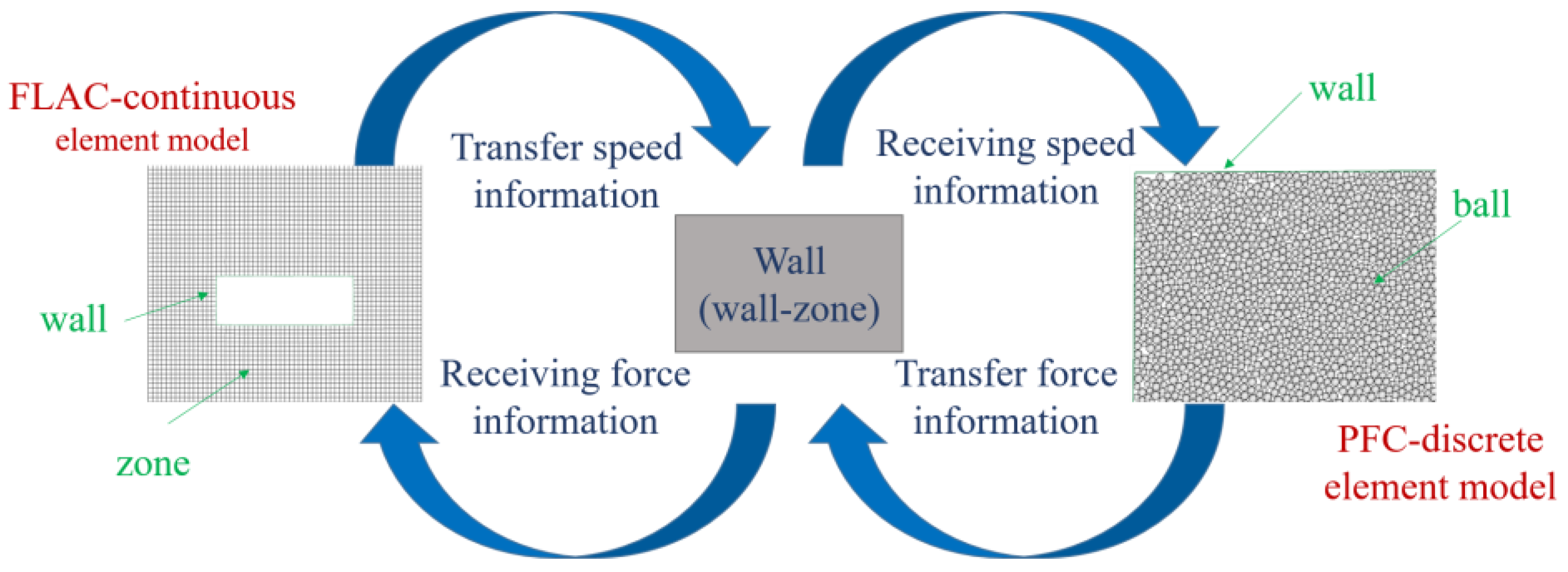
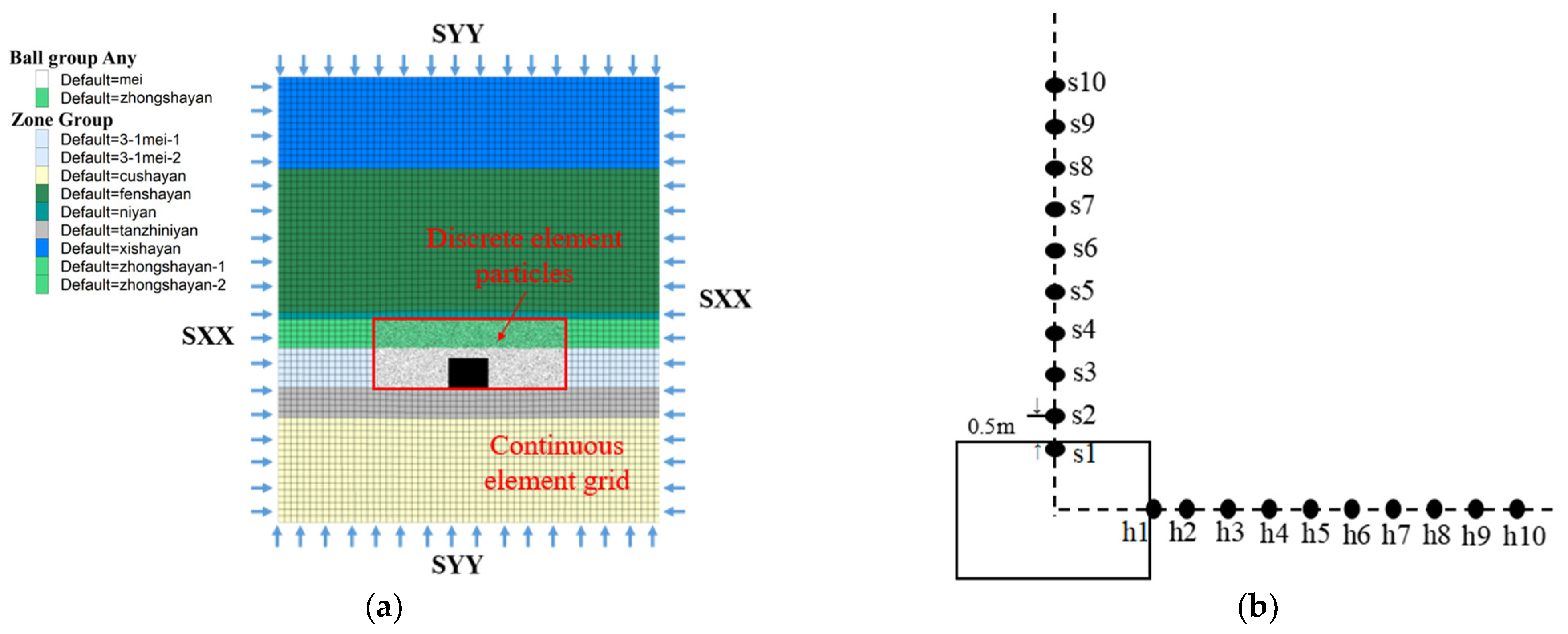

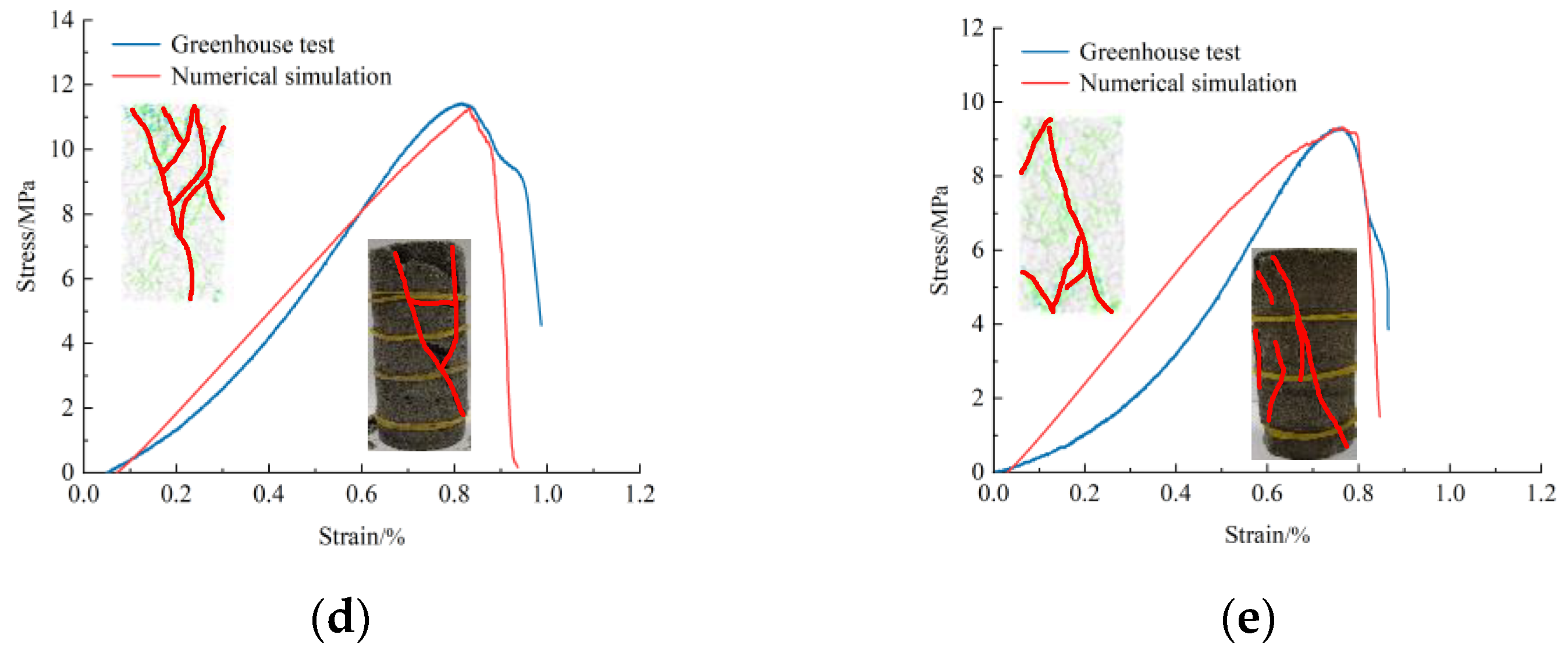


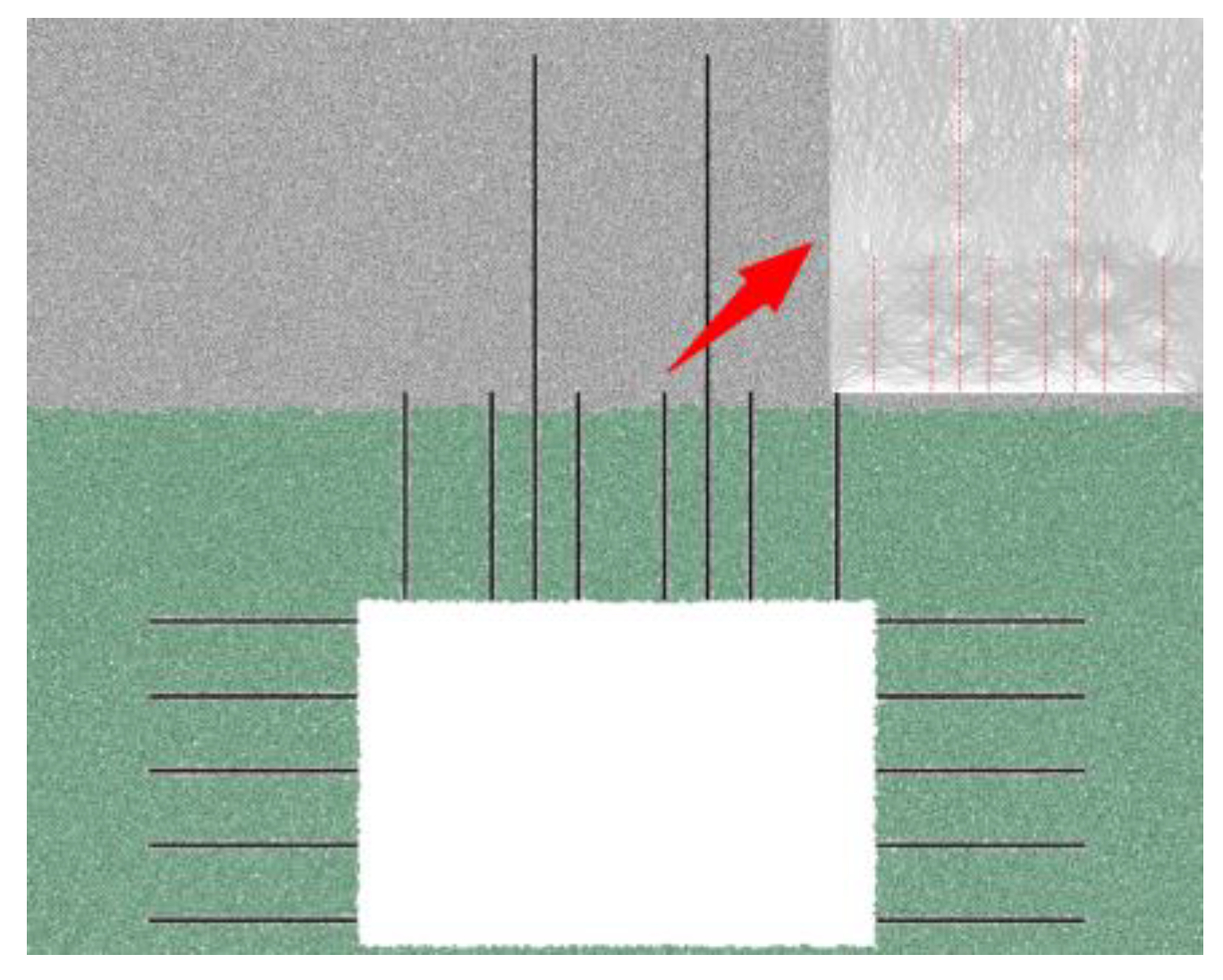
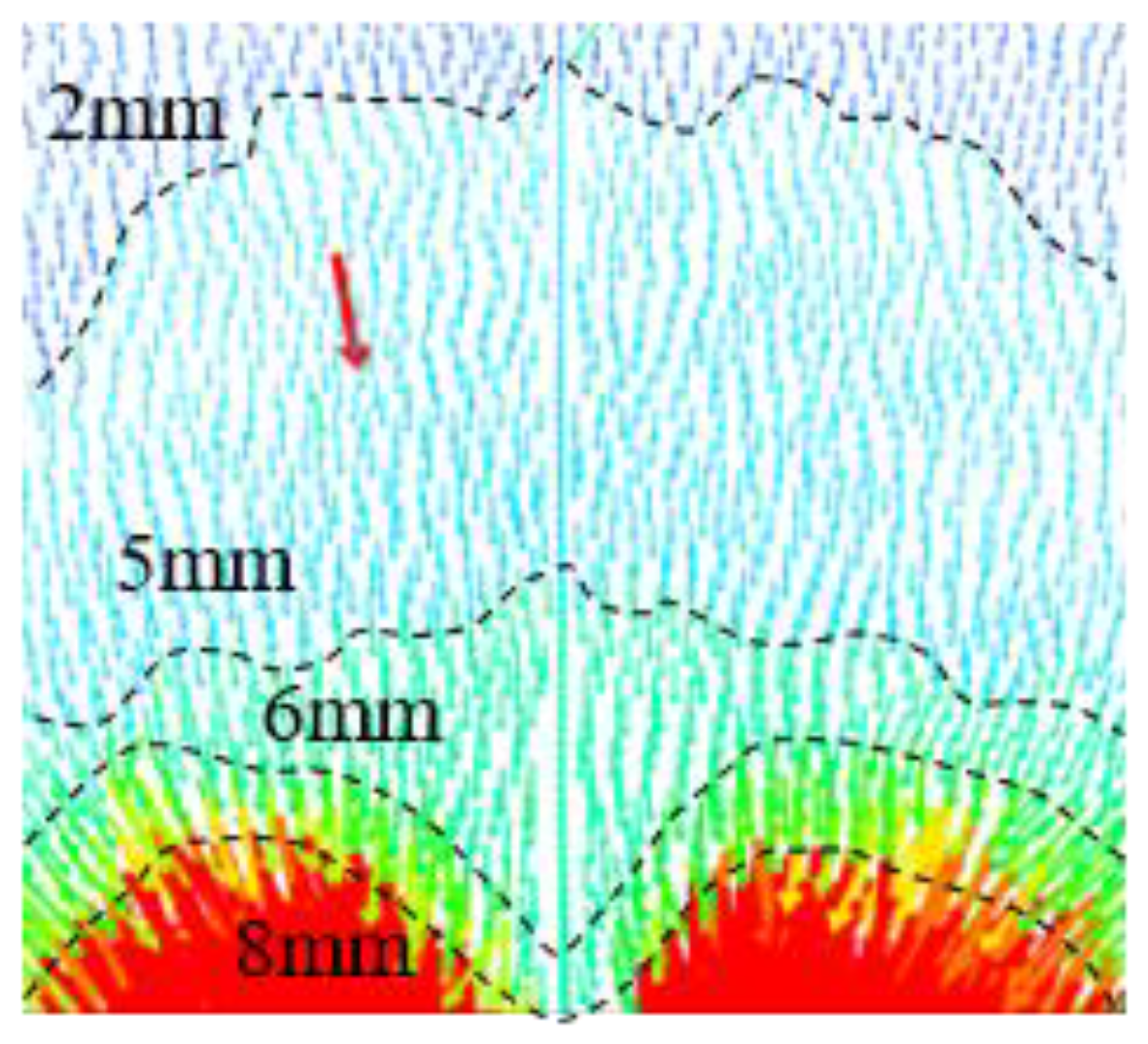
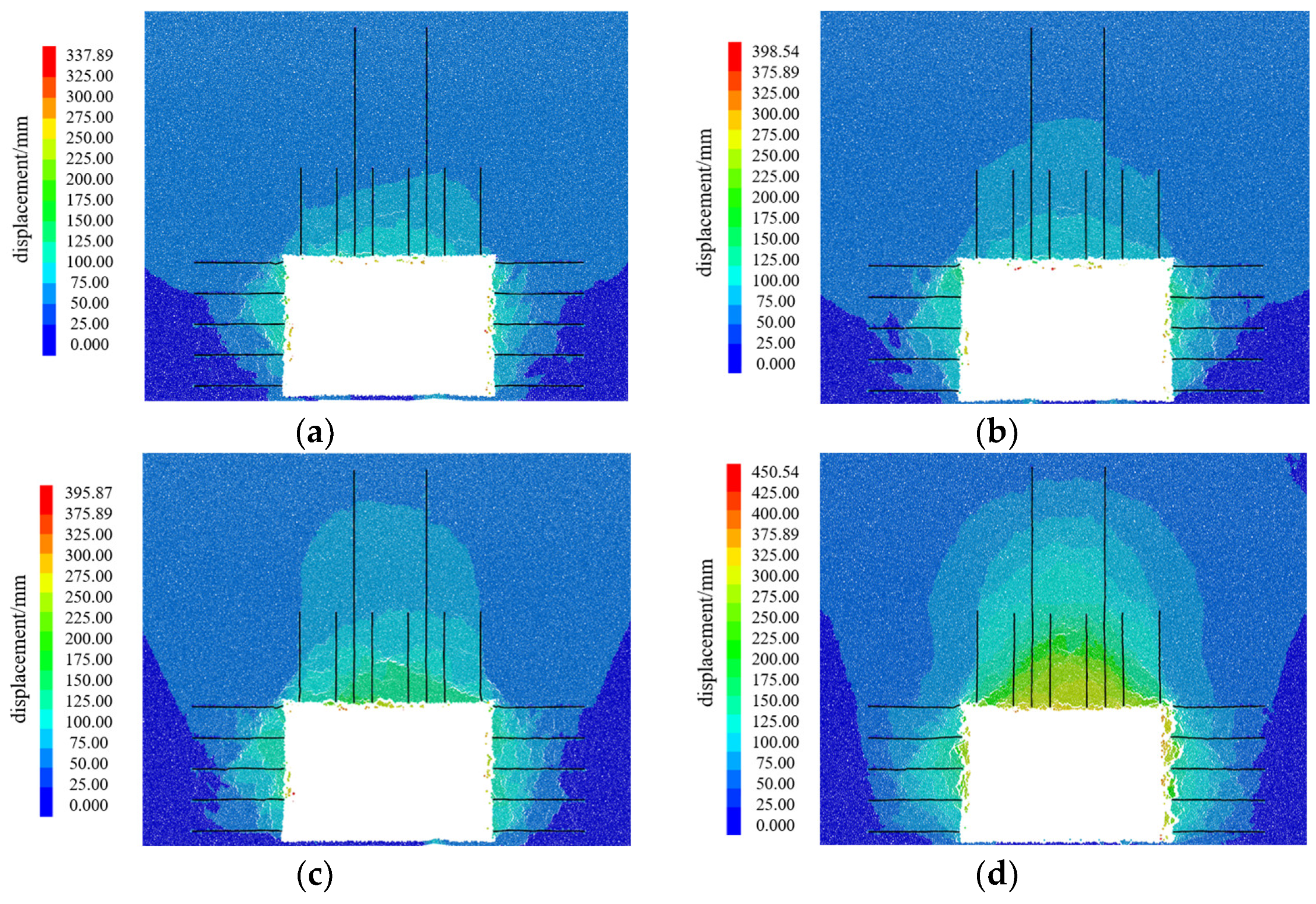

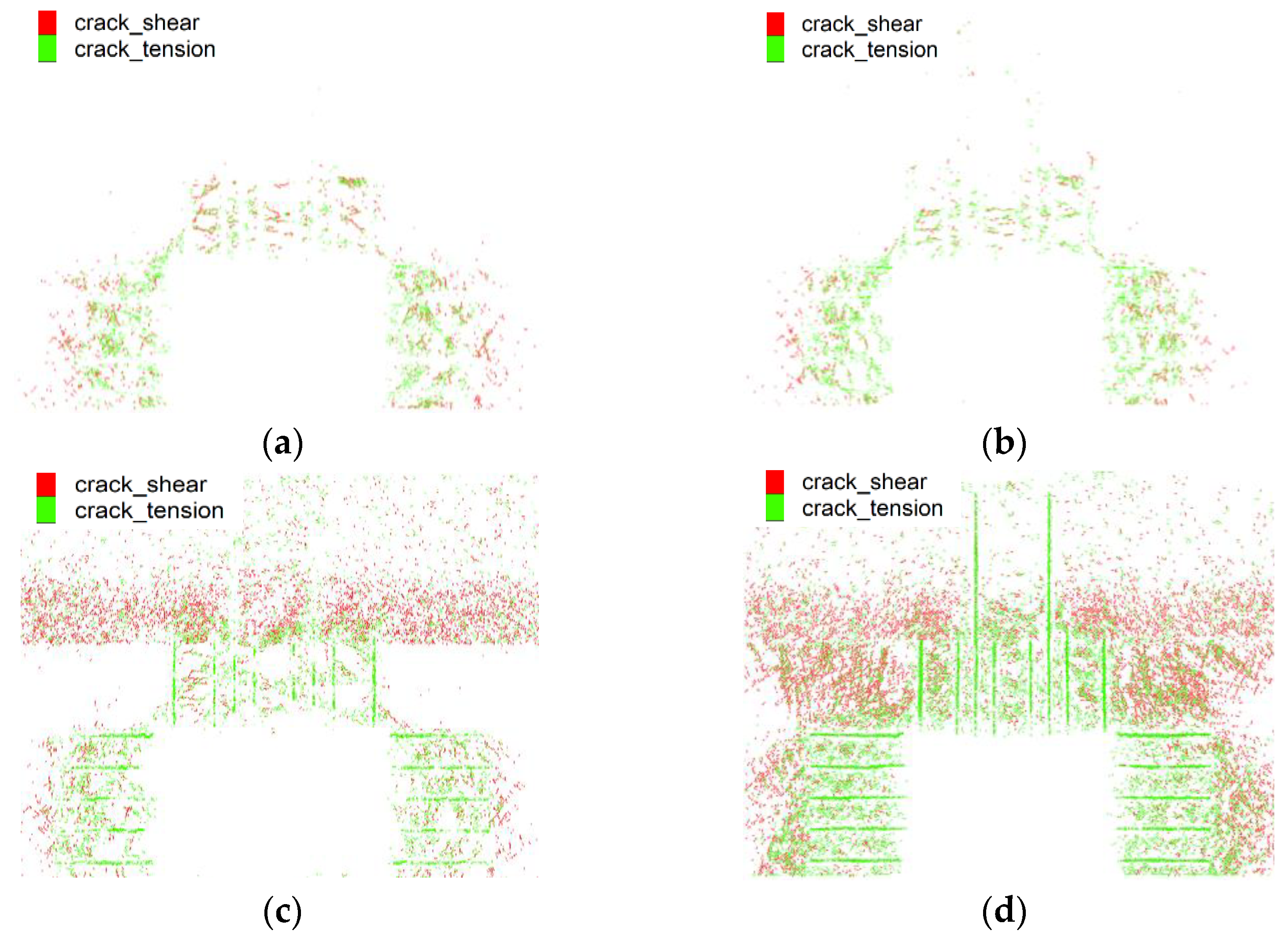
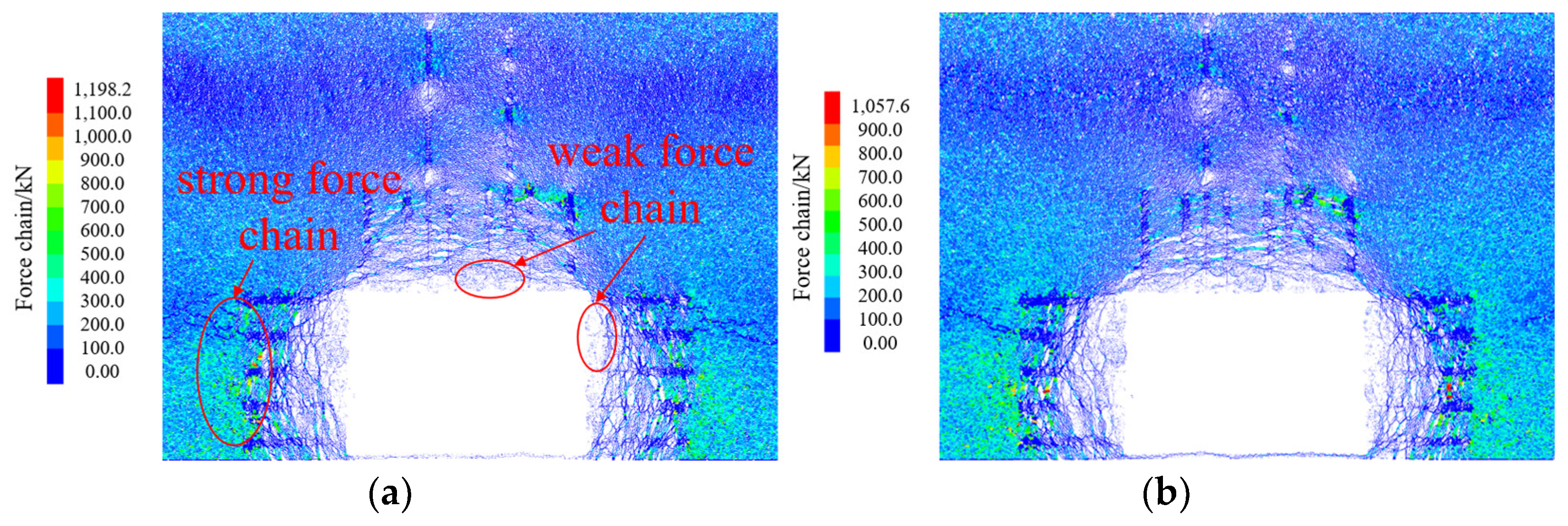

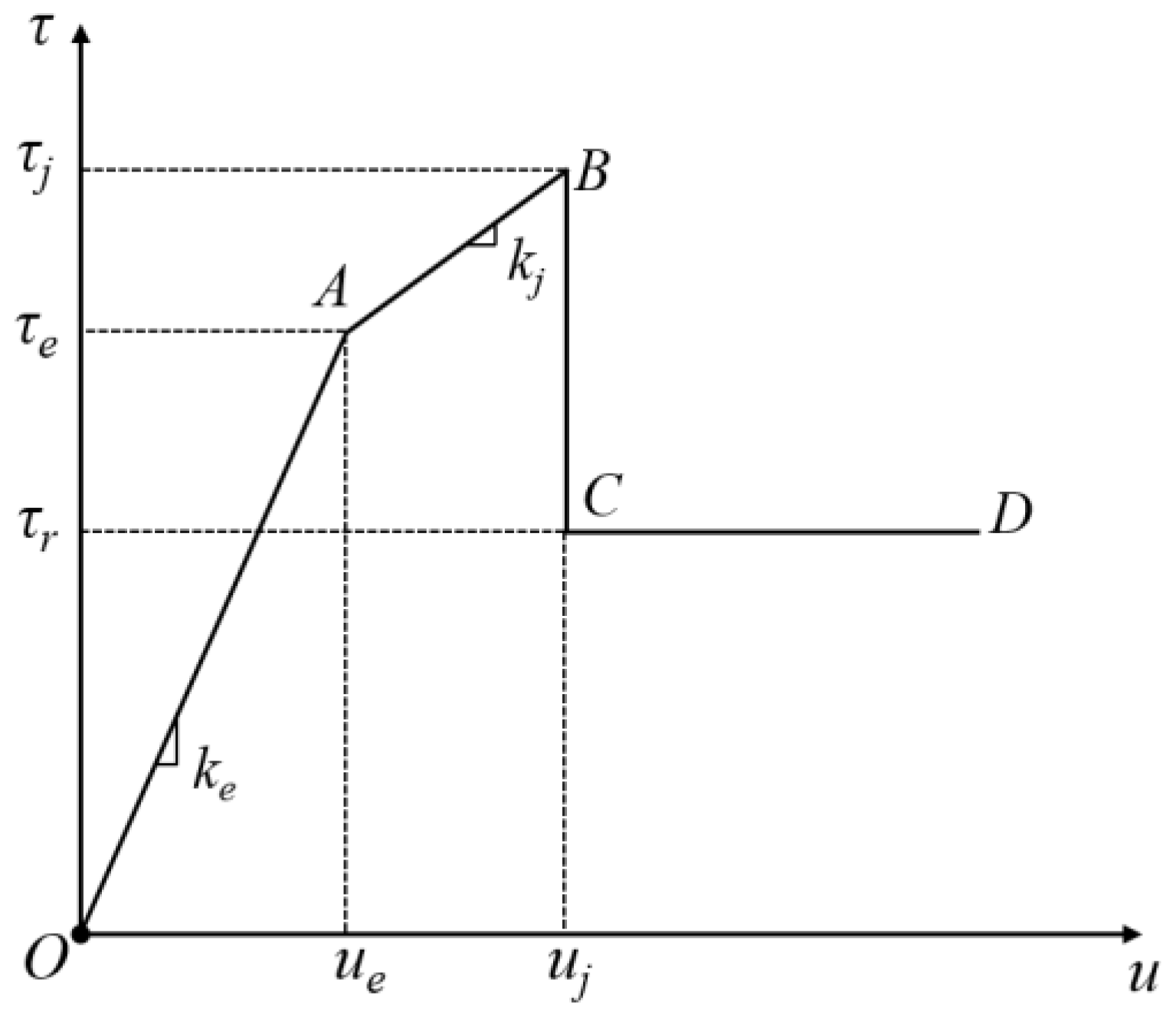
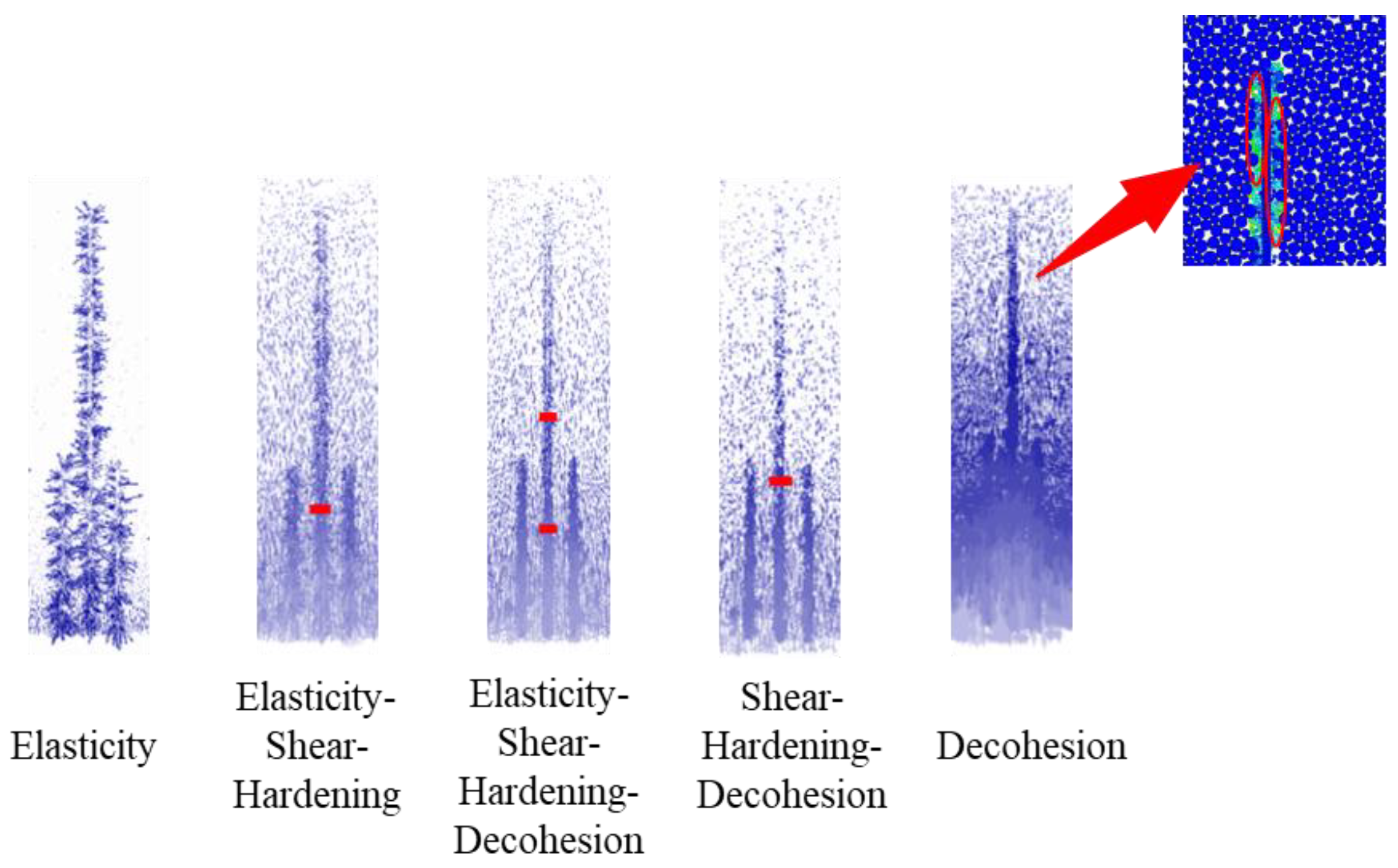

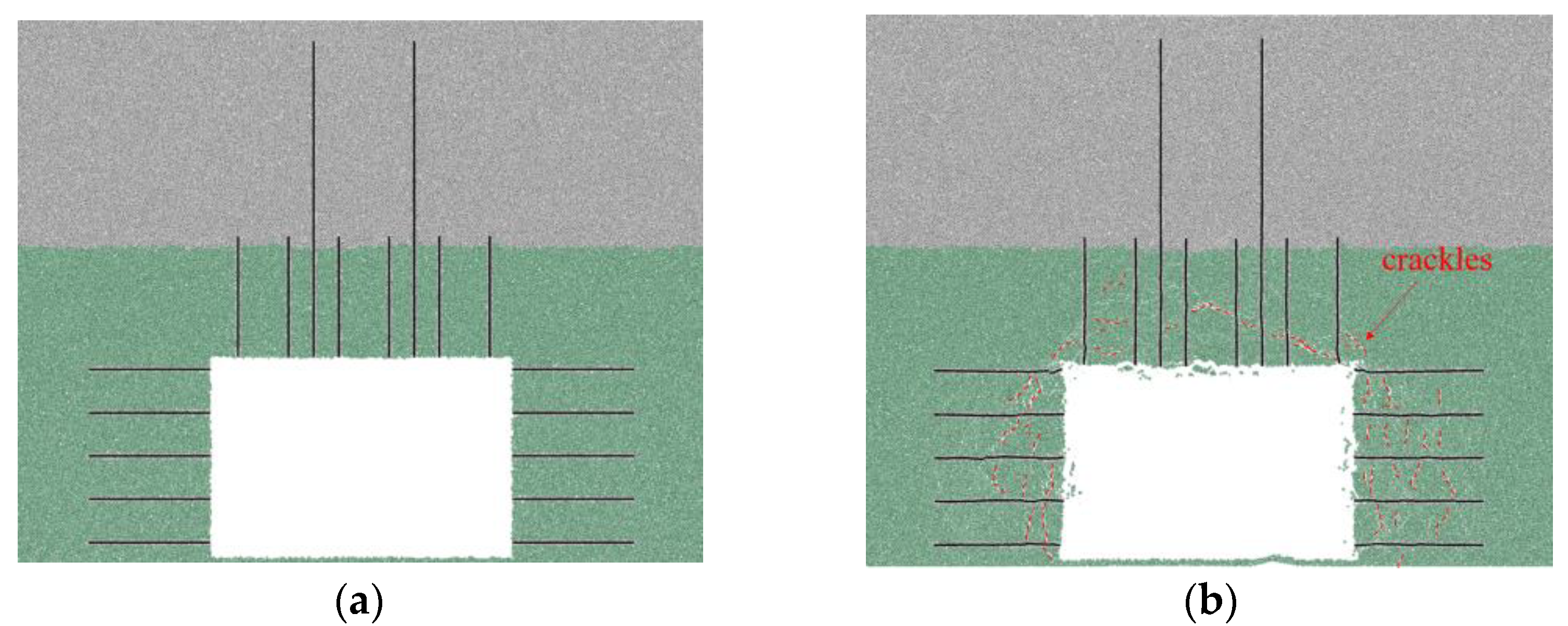
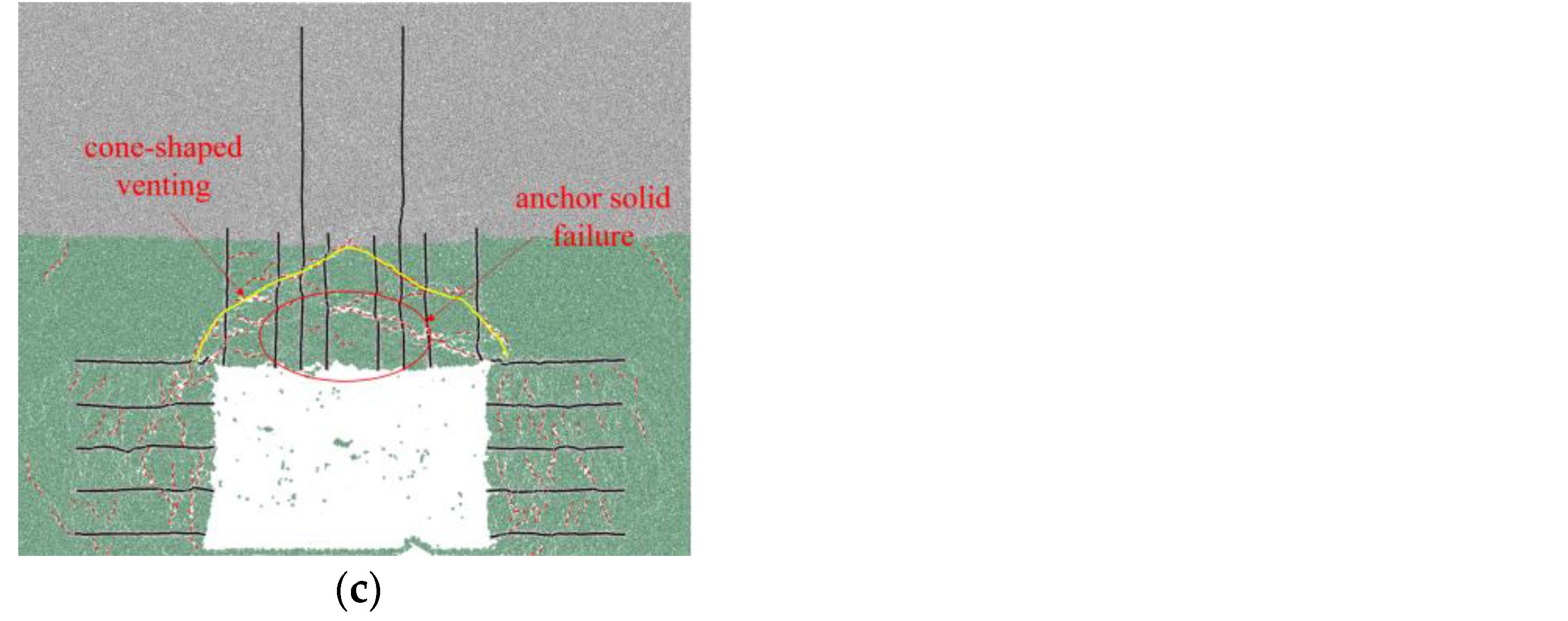
| Lithology | ρ/kg·m−3 | K/GPa | C/MPa | φ/(°) | σt/MPa |
|---|---|---|---|---|---|
| Fine sandstone | 2820 | 8.5 | 3.1 | 42 | 2.2 |
| Siltstone | 2650 | 7.9 | 2.4 | 35 | 1.8 |
| Gritstone | 2500 | 9.5 | 3.8 | 40 | 3.3 |
| Sandy mudstone | 1960 | 4.7 | 2.9 | 33 | 2.4 |
| Medium sandstone (0% moisture content) | 2250 | 2.7 | 1.9 | 6.15 | 26.1 |
| Medium sandstone (2.3% moisture content) | 2250 | 2.1 | 1.7 | 4.92 | 22.3 |
| Medium sandstone (5.5% moisture content) | 2250 | 1.8 | 1.4 | 3.52 | 19.3 |
| Medium sandstone (7.8% moisture content) | 2250 | 1.7 | 1.1 | 3.04 | 17.8 |
| 3-1 Coal | 1380 | 1.7 | 0.6 | 18 | 0.5 |
| Carbonaceous mudstone | 1450 | 2.0 | 0.7 | 19 | 0.6 |
| Groups | Linear Contact Parameters | Parallel-Bonding Model Parameters | |||||
|---|---|---|---|---|---|---|---|
| Form | Emod /GPa | kratio | pb_emod /GPa | pb_kratio | pb_coh /MPa | pb_ten /MPa | pb_fa /(°) |
| 3-1 Coal | 1.5 | 1.5 | 1.5 | 1.5 | 3.7 | 3.7 | 18 |
| Medium sandstone (0% moisture content) | 1.5 | 1.0 | 1.5 | 1.0 | 8.2 | 12.3 | 40 |
| Medium sandstone (2.3% moisture content) | 1.4 | 1.13 | 1.4 | 1.13 | 5.3 | 10.0 | 36.4 |
| Medium sandstone (5.5% moisture content) | 1.25 | 1.32 | 1.25 | 1.32 | 3.56 | 9.1 | 34.2 |
| Medium sandstone (7.8% moisture content) | 1.1 | 1.55 | 1.1 | 1.55 | 2.13 | 8.6 | 32.6 |
Disclaimer/Publisher’s Note: The statements, opinions and data contained in all publications are solely those of the individual author(s) and contributor(s) and not of MDPI and/or the editor(s). MDPI and/or the editor(s) disclaim responsibility for any injury to people or property resulting from any ideas, methods, instructions or products referred to in the content. |
© 2023 by the authors. Licensee MDPI, Basel, Switzerland. This article is an open access article distributed under the terms and conditions of the Creative Commons Attribution (CC BY) license (https://creativecommons.org/licenses/by/4.0/).
Share and Cite
Sun, L.; Jiang, Z.; Long, Y.; He, Q.; Zhang, H. Investigating the Mechanism of Continuous–Discrete Coupled Destabilization of Roadway-Surrounding Rocks in Weakly Cemented Strata under Varying Levels of Moisture Content. Processes 2023, 11, 2556. https://doi.org/10.3390/pr11092556
Sun L, Jiang Z, Long Y, He Q, Zhang H. Investigating the Mechanism of Continuous–Discrete Coupled Destabilization of Roadway-Surrounding Rocks in Weakly Cemented Strata under Varying Levels of Moisture Content. Processes. 2023; 11(9):2556. https://doi.org/10.3390/pr11092556
Chicago/Turabian StyleSun, Lihui, Zhixin Jiang, Yaxin Long, Qingfeng He, and Haiyang Zhang. 2023. "Investigating the Mechanism of Continuous–Discrete Coupled Destabilization of Roadway-Surrounding Rocks in Weakly Cemented Strata under Varying Levels of Moisture Content" Processes 11, no. 9: 2556. https://doi.org/10.3390/pr11092556




